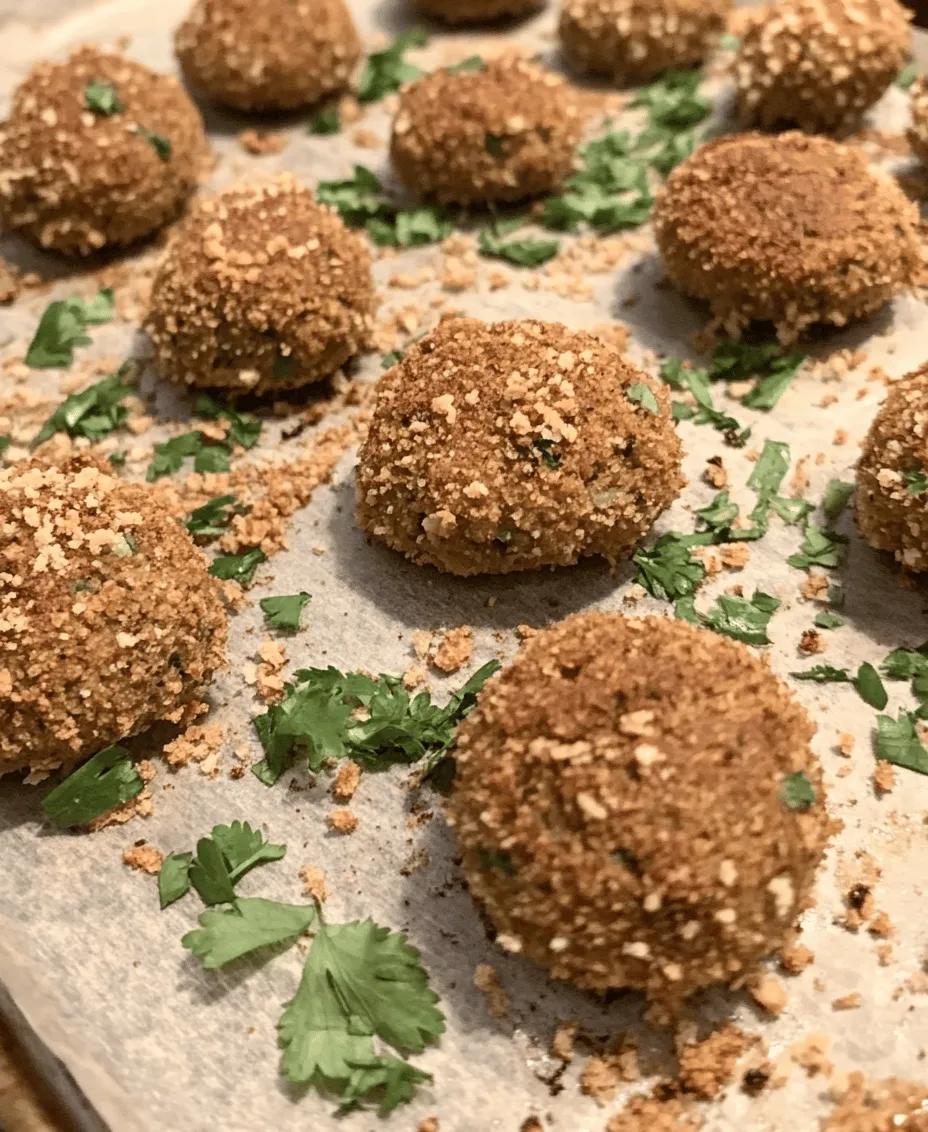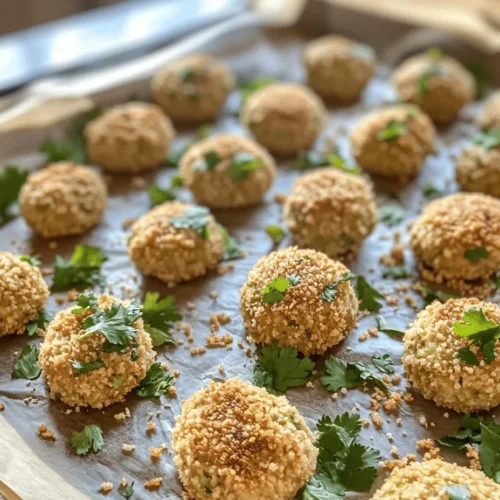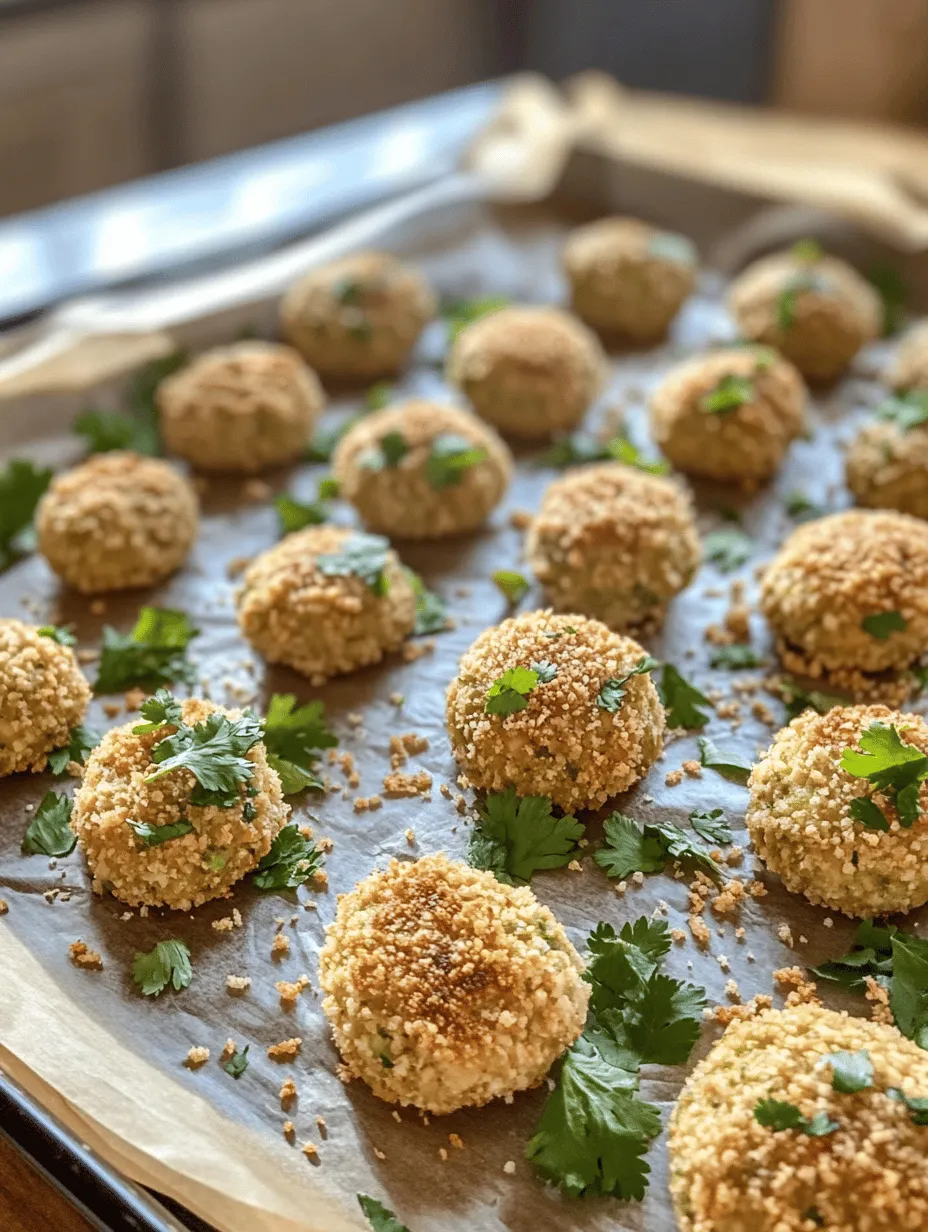Introduction
Falafel is a beloved dish originating from the Middle East, cherished for its crispy exterior and savory, herb-infused interior. Traditionally made from ground chickpeas or fava beans, falafel is often served in pita bread, topped with fresh vegetables and drizzled with tahini or yogurt sauce. Its versatility allows it to be enjoyed as a sandwich, salad topping, or even as a stand-alone snack.
While you can easily find pre-made falafel at grocery stores or street vendors, making falafel at home has numerous advantages. Homemade falafel allows you to control the ingredients, ensuring a fresher and healthier product. You can also customize the spices and herbs to suit your taste preferences, creating a dish that’s uniquely your own. For those seeking a healthier alternative, our Crispy Easy Baked Falafel recipe offers a plant-based option that is lower in calories and fat compared to its deep-fried counterparts, without sacrificing flavor or crunch.
Understanding Falafel
Historical Background and Cultural Significance
The origins of falafel are somewhat debated, with both Egypt and the Levant claiming its invention. However, it is generally agreed that falafel has been a staple in Middle Eastern cuisine for centuries. The word “falafel” is derived from the Arabic word “falafil,” which refers to a small round ball or a fritter. Traditionally, falafel was made with fava beans, but chickpeas gained popularity over time, especially in countries like Israel, where they are now the primary ingredient.
Falafel holds significant cultural importance in many Middle Eastern countries, often served during festive occasions, family gatherings, and street food fairs. It symbolizes a rich culinary heritage and is enjoyed by people of all backgrounds, making it a truly universal dish.
Traditional Versus Modern Adaptations
While traditional falafel relies on deep-frying for that signature crispy texture, modern adaptations have emerged to cater to health-conscious consumers. Baking falafel is a fantastic alternative that reduces the amount of oil used while still achieving a delightful crunch. This recipe embraces the essence of traditional falafel while adapting it for modern kitchens, making it accessible to everyone, including those with dietary restrictions.
In recent years, creative variations of falafel have also surfaced, incorporating additional ingredients like sweet potatoes, quinoa, and various spices, further expanding the flavor profile and nutritional benefits of this iconic dish.
Nutritional Benefits of Chickpeas and Herbs
Chickpeas, the primary ingredient in our recipe, are a powerhouse of nutrition. They are an excellent source of plant-based protein, making them a fantastic option for vegetarians and vegans. Additionally, chickpeas are rich in fiber, which aids digestion and helps maintain a healthy gut. They also contain essential vitamins and minerals, including iron, magnesium, and B vitamins.
The fresh herbs used in this recipe, such as parsley and cilantro, not only add vibrant flavors but also provide a host of health benefits. Parsley is known for its high vitamin K content, which is vital for bone health, while cilantro is packed with antioxidants and may help in detoxifying the body.
Ingredients Breakdown
To create the perfect batch of crispy baked falafel, you’ll need the following ingredients:
Chickpeas
Chickpeas, also known as garbanzo beans, are the star of the show in any falafel recipe. They provide the main structure and protein content. When preparing falafel, it’s essential to use dried chickpeas that have been soaked overnight rather than canned varieties. Dried chickpeas maintain their texture better when processed, resulting in a more cohesive mixture. Soaking also helps reduce cooking time and enhances digestibility.
Onion and Garlic
Onion and garlic are integral flavor enhancers in our falafel. They not only add depth to the taste but also come with health benefits. Onions are known for their anti-inflammatory properties and can aid in heart health, while garlic is celebrated for its immune-boosting capabilities.
Fresh Herbs: Parsley and Cilantro
Using fresh herbs like parsley and cilantro elevates the flavor profile of the falafel. Both herbs are nutrient-dense, providing vitamins A, C, and K, along with antioxidants that can support overall health. The combination of these herbs delivers a fresh, vibrant taste that is essential for authentic falafel.
Ground Flaxseed
Ground flaxseed serves a dual purpose in this recipe. Firstly, it acts as a binding agent, helping the falafel mixture hold together as it bakes. Secondly, flaxseed is a rich source of omega-3 fatty acids, which are important for heart health and can contribute to reduced inflammation. Incorporating flaxseed into your falafel not only enhances its nutritional value but also provides a subtle nutty flavor.
Olive Oil
Olive oil is an essential ingredient in this recipe, not just for flavor but also for its health benefits. Rich in monounsaturated fats, olive oil can support heart health and offer anti-inflammatory properties. Using a drizzle of olive oil helps to achieve that crispy texture when baking the falafel, providing a golden-brown finish that is visually appealing and delicious.
Spices: Cumin and Coriander
Cumin and coriander are staples in Middle Eastern cuisine and are critical to the flavor of falafel. Cumin has a warm, earthy flavor that enhances the overall taste, while coriander offers a citrusy note that brightens the dish. Together, these spices create a harmonious balance that is both comforting and exotic.
Baking Powder
Baking powder plays a crucial role in achieving the right texture for baked falafel. It helps the mixture rise slightly, ensuring that the falafel is light and fluffy on the inside while remaining crispy on the outside. This ingredient is key to replicating that coveted texture that many love about traditional fried falafel.
Salt and Pepper
Salt and pepper are essential for enhancing the flavors of all the ingredients. Salt helps to draw out the natural tastes, while pepper adds a touch of heat. Together, they create a well-balanced dish that is far from bland.
Breadcrumbs
To finish off the falafel, breadcrumbs are often used to create a crispy exterior. For those following gluten-free diets, alternatives such as almond flour or gluten-free breadcrumbs can be used. Whole wheat breadcrumbs are also a great option for those seeking a healthier alternative. The choice of breadcrumbs can significantly impact the texture and nutritional profile of the finished product.
Step-by-Step Instructions for Making Crispy Baked Falafel
Preparation Phase
Before diving into the recipe, it’s important to prepare your workspace and ingredients. Start by preheating your oven to 400°F (200°C). Preheating is crucial as it ensures that the falafel cooks evenly and achieves that perfect crispy exterior.
Next, prepare a baking sheet by lining it with parchment paper. This will prevent the falafel from sticking and make cleanup a breeze. If you don’t have parchment paper, a light coating of olive oil on the baking sheet will suffice.
Tips on Using a Food Processor Effectively
One of the most efficient tools for making falafel is a food processor. It allows you to quickly and evenly blend the ingredients. Begin by adding the soaked chickpeas to the food processor, followed by the chopped onion, garlic, parsley, cilantro, ground flaxseed, olive oil, and spices.
Pulse the mixture until it is finely chopped but still has some texture. Avoid over-processing, which can lead to a mushy mixture. You want to achieve a consistency that holds together when formed into balls or patties. If the mixture feels too wet, you can add a small amount of flour or breadcrumbs to help bind it.
Once your mixture is ready, transfer it to a bowl and let it rest for about 10-15 minutes. This allows the flavors to meld together and makes it easier to form the falafel shapes.
With this introduction and the first steps outlined, you are well on your way to creating a delicious batch of crispy baked falafel. The combination of fresh ingredients, spices, and thoughtful preparation will ensure your homemade falafel is a hit whether served as a meal or appetizer. Stay tuned for the next part of the recipe, where we will guide you through the shaping, baking, and serving suggestions for this delightful dish.

Mixing and Shaping
The first step to achieving perfectly crispy baked falafel begins with the mixing and shaping process. To create an ideal falafel mixture, you will start by combining your ingredients in a food processor. This includes the soaked chickpeas, garlic, onion, fresh herbs (like parsley and cilantro), spices (such as cumin and coriander), and a pinch of salt. The goal is to blend these ingredients until they are finely chopped but not pureed. You want the mixture to be coarse enough to retain some texture, which will help the falafel hold its shape during baking.
Techniques for Achieving the Perfect Falafel Texture
When mixing your falafel, pay attention to the texture. A well-balanced falafel mixture should be slightly sticky but not overly wet. If the mixture feels too dry, you can add a small amount of water or a splash of lemon juice to enhance the moisture without compromising the structure. Conversely, if it’s too wet, you can add a tablespoon of flour (chickpea flour works best for gluten-free options) to help bind the ingredients together.
Insights into Shaping the Patties for Even Cooking
Once your mixture is ready, it’s time to shape the patties. Using your hands, take a small amount of the mixture (about 2 tablespoons) and roll it into a ball, then flatten it slightly to form a patty. For even cooking, aim for uniform thickness—about ½ inch thick works well. This will ensure that each falafel cooks at the same rate, resulting in a consistent texture and flavor across the batch. Arrange the shaped patties on a parchment-lined baking sheet, ensuring they are spaced apart to allow for air circulation during baking.
Baking Process
Now that your falafel is shaped, it’s time to bake them to crispy perfection. Preheat your oven to 400°F (200°C) to ensure that the falafel will cook evenly and develop a beautiful golden crust.
Optimal Baking Tips for Achieving Crispiness
To achieve that desired crispiness without frying, consider lightly spraying or brushing the falafel patties with olive oil before baking. This will enhance browning and create a delightful crunch on the outside. Bake the falafel for about 20 minutes, then carefully flip each patty over to promote even cooking and browning on both sides.
Importance of Flipping the Falafel Halfway Through for Even Browning
Flipping the falafel halfway through the baking time is crucial. This step not only helps achieve uniform color but also allows moisture to escape from the bottom side of the patties, preventing them from becoming soggy. After flipping, continue baking for an additional 10-15 minutes, or until the falafel is golden brown and crispy on both sides.
Serving Suggestions
Crispy baked falafel is as versatile as it is delicious, making it a perfect addition to a variety of meals. Here are some creative serving ideas to inspire you.
Traditional Accompaniments: Pita Bread, Tahini Sauce, and Salads
For a classic presentation, serve your falafel in warm pita bread, topped with fresh vegetables like tomatoes, cucumbers, and shredded lettuce. Drizzle with tahini sauce for a creamy, nutty flavor that complements the spices in the falafel. You can also serve a side of tabbouleh or a simple green salad to add freshness to your meal.
Modern Twists: Falafel Bowls, Wraps, and Vegan Burgers
If you’re looking for a modern twist, try assembling falafel bowls with a base of quinoa or brown rice, topped with roasted vegetables, avocado, and a dollop of tzatziki or hummus. Alternatively, wrap falafel in a whole grain tortilla with mixed greens and a zesty sauce for a hearty lunch. For a fun twist, form the falafel mixture into larger patties for vegan burgers, served on a whole grain bun with all your favorite toppings.
Pairing Ideas: Best Side Dishes and Beverages to Complement Falafel
When it comes to sides, consider serving your falafel with sweet potato fries or a refreshing cucumber and yogurt salad. For beverages, a light mint lemonade or a crisp white wine can perfectly complement the flavors of your meal.
Nutritional Information
Baked falafel is not only delicious but also packed with nutritional benefits, making it a great option for health-conscious eaters.
Detailed Analysis of the Nutritional Content of the Recipe
Each serving of baked falafel provides a good source of protein, fiber, and essential vitamins and minerals. Chickpeas, the primary ingredient, are rich in protein and fiber, promoting satiety and aiding in digestion. Furthermore, herbs like parsley and cilantro add vitamins A, C, and K, enhancing the overall nutrient profile.
Health Benefits Associated with Consuming Baked Falafel Over Fried Options
Opting for baked falafel instead of fried significantly reduces the calorie and fat content of the dish. Baking allows for a crispy exterior without the need for excessive oil, making it a healthier choice. This method retains the wholesome goodness of chickpeas while avoiding the added unhealthy fats associated with frying.
Discussion on Portion Sizes and Dietary Considerations (Vegan, Gluten-Free)
A standard serving size of falafel is typically around 2-3 patties, depending on your overall meal. This recipe is naturally vegan and can easily be made gluten-free by using chickpea flour or a gluten-free breadcrumb alternative as a binder. Always monitor portion sizes if you are balancing caloric intake, especially when serving with high-calorie accompaniments.
Common FAQs About Falafel
Addressing Common Questions and Concerns About Making Falafel
Can I use dried chickpeas instead of canned?
Yes, dried chickpeas can be used, but they need to be soaked overnight and cooked until tender before using them in the falafel mixture. This step is crucial as it ensures the right texture.
How can I store leftover falafel?
Leftover falafel can be stored in an airtight container in the refrigerator for up to 4 days. They can also be frozen for longer storage. Just make sure to reheat them in the oven to retain their crispiness.
Can this recipe be made ahead of time?
Absolutely! You can prepare the falafel mixture and shape the patties in advance. Store them in the refrigerator for up to 24 hours before baking. For longer storage, freeze the shaped patties and bake them directly from frozen, adding a few extra minutes to the bake time.
Variations for Added Flavor or Dietary Restrictions
Feel free to experiment with spices and herbs! Adding ingredients like smoked paprika, chili powder, or even a hint of cinnamon can provide unique flavor profiles. For those with nut allergies, ensure that your tahini or any other sauces are nut-free.
Conclusion
Making crispy easy baked falafel at home is not just a rewarding culinary experience; it also allows you to enjoy a delicious and nutritious meal tailored to your preferences. With its versatile nature, falafel can be served in countless ways, ensuring that you never get bored of this delightful dish. Whether you enjoy them in a classic pita, a vibrant bowl, or as a hearty burger, the satisfaction of preparing a wholesome, homemade meal is unmatched.
Don’t hesitate to experiment with different flavors and serving styles! With a little creativity, your baked falafel can take center stage in any meal, providing nourishment and delight to you and your loved ones. Enjoy the journey of exploring this beloved Middle Eastern dish, and revel in the joy of sharing it with others.



